When I heard Wizards of the Coast released a new mobile game — an entry into the lucrative wave of Hearthstone-like digital card games, with a splash of Magic: The Gathering elements — I was immediately turned off. I thought, “Sure, I’ll try it out for a week and get bored,” and I even gave it a negative review that first day.
I am obsessed with Magic Spellslingers. I’ve been an active daily player without fail and built a robust collection without spending a dime. However, playing that much has revealed how certain facets, especially as to where it lines up with MTG versus where it diverges, are not necessarily intuitive — for seasoned Magic players most of all.
So over the next few weeks, I’ll spell out the game’s basics and under-signaled details, then get into some advanced strategy and how it differs from traditional CCGs — all with a special eye toward preparing Magic players for what to expect. You may want to bookmark this URL for later, as the page you’re reading right now is both the first part in the series, as well as the hub page for, The Ultimate Guide to Magic Spellslingers.
At the time of this writing, Magic Spellslingers is available on iOS, Android, and Steam.
The following table of contents will evolve and change as new entries in the series are published, and will always link to each published entry.
- Part I: Introduction (This page)
- Gameplay Basics
- Card Types
- Core Mechanics
- Part II: Spellslingers and Archetypes
- The Monocolored Slingers
- Part III: Spellslingers and Archetypes
- The Allied-Color Slingers
- Part IV: Spellslingers and Archetypes
- The Enemy-Color Slingers
- Part V: Building Your Collection
- The Lower Leagues
- The Endgame
- Part VI: Advanced Strategy
- Tempo on the Draw
- Curves + Ratios
- Variant Builds
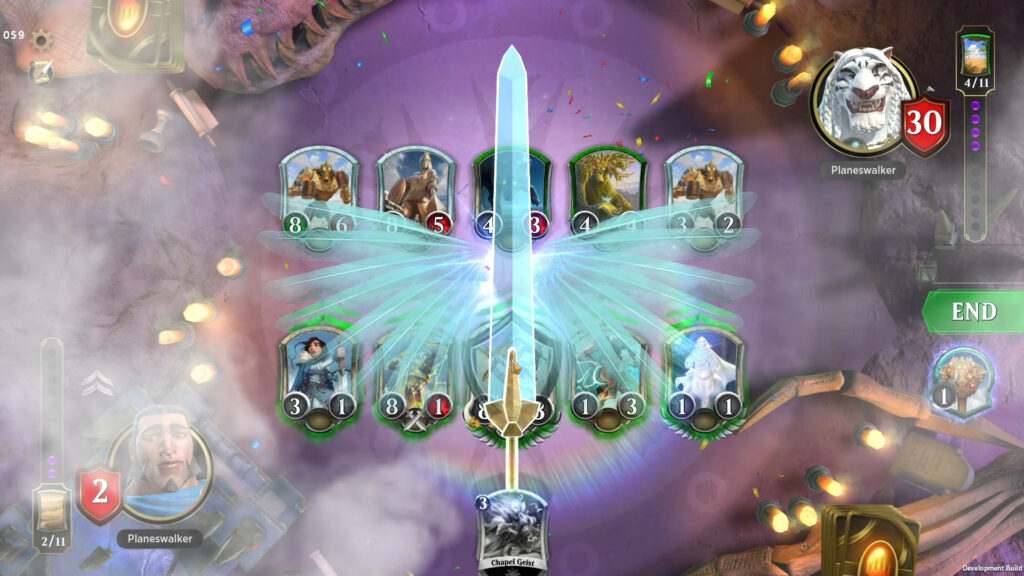
Gameplay Basics
Deck Construction
Every deck in Spellslingers is exactly 30 cards plus one land, and is built around one of Magic‘s iconic Planeswalkers, who in this game are called…Spellslingers. (Except for the one time in the intro sequences where the “host’s” voice says “Planeswalkers,” even though the text says “Spellslingers.” lol.) A deck can have up to two copies of any given card, but only one copy of any given Legendary.
Every Spellslinger has a set of unique properties that inform how you build around them: their life total (always 20 or more); a defining Vanguard-style ability, some of which are passive and some of which are activated; three Signature cards that no other Spellslinger can use; and a deckbuilding restriction related to their color identity and quantity or type of splash cards. (The last of those is how this game iterates on Magic‘s color pie, rather than having different colors of mana for different costs.)
For example, the Spellslinger every player starts with is Chandra. She has 24 life, and like most single-colored ‘Slingers, a Chandra deck can choose exactly one splash color and include up to six cards of that color (on top of any number of cards in her base color). Her passive ability just straight-up deals 4 damage to your opponent at the start of the game. This isn’t quite as impactful as it might sound, but she makes up for it with a Signature suite of some of the game’s most potent red cards, like this one:
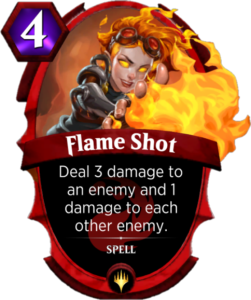
Cards, Mana Gems, and Turn Phases
If you’ve played other digital-first CCGs, many elements of Spellslingers will be familiar.
The player who goes first starts with a three-card hand, while the player who goes second starts with four. Before the game begins, each player can send any number of those cards back to their deck to replace them. Unlike in traditional 60-card Magic, both players draw a card at the beginning of their first turn, rather than only the player going second.
Each turn, you get an additional mana gem, which in Magic terms works more or less like a guaranteed land drop. The player going second also starts the game with a “fragile” mana gem, which is an extra mana that, unlike normal mana gems, does not recur on future turns once spent. This means that in some situations and archetypes, going second can actually give you both card advantage and tempo advantage, a topic I’m excited to return to in a later installment.
Some cards and abilities can also generate “empty” mana gems, which are sort of like Rampant Growth effects in Magic: they increase your overall mana gem count but don’t “fill” until next turn, providing a ramp/setup mechanic.
The maximum number of cards you can have in your hand is ten, and in a stark distinction from Magic, a card that would go into your hand by any means when your hand is already full simply…gets discarded instead. If you don’t keep this in mind, it can lead to some unfortunate feel-bad moments in any deck that quickly fills up your hand, where exactly the card you need appears before you and then disappears in a puff of sparkles — while an annoying voice chimes, “Too many cards!”
Perhaps the biggest core difference in gameplay from Magic to Spellslingers is that in the latter, you can only directly play cards on your own turn, in the unspoken equivalent of a “main phase.” (See “Traps” below for some exceptions.) So far there are no cards that reference an “upkeep” step or effects that take place before you draw, so as of right now, the known parts of the turn appear to correlate to: draw → main phase → combat → main phase → end/cleanup step.
Card Types
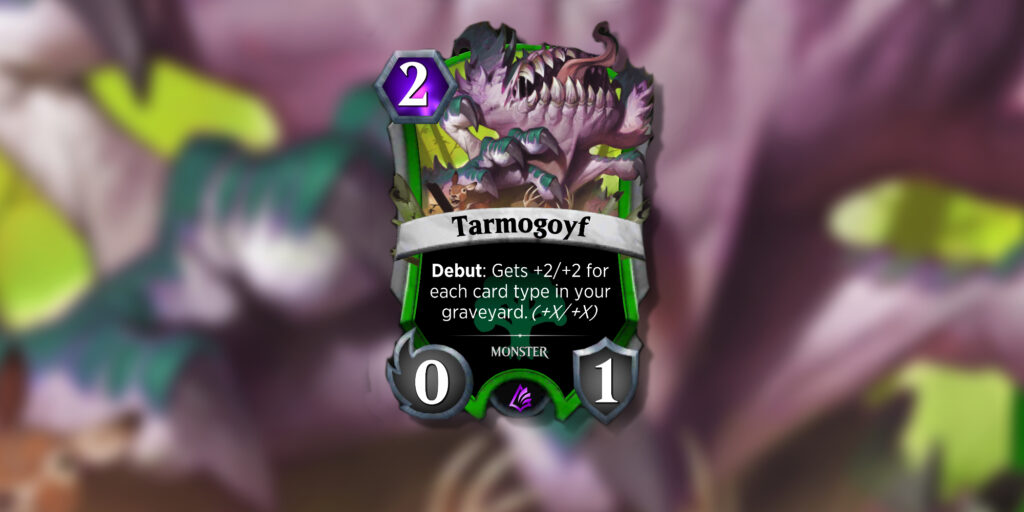
Creatures in Spellslingers work very similarly to those in Magic, but with subtle key differences. As you probably expect, they sit on the battlefield as permanents; have power and toughness representing their capacity to deal and receive damage; can attack and/or block; and experience “summoning sickness” unless they have haste.
However, creatures in Spellslingers actually lose toughness when taking damage, more akin to a “health” mechanic (which is, not incidentally, how a lot of first-time players initially assume toughness works in Magic). There’s also no “tapping” in Spellslingers, which means that, in MTG terms, all creatures essentially have vigilance.
As a sort of tradeoff — and to keep gameplay simple — only one blocker can be assigned to any attacker. Not only that, but combat is resolved for each block one at a time, before any unblocked attacks then resolve all at once. This means you need to consider how you sequence your blocks, because trample damage or damage triggers will take place each time you decide one. (More on this shortly, under “Traps.”)
Each player’s board state is limited to a maximum of five creatures. This leads to non-intuitive interactions, both to be wary of and to exploit. If an effect like Grave Titan’s would summon a creature when you already have five out, instead it does nothing. If you cast Turn to Stone on an enemy creature while your board is full — which normally transforms that creature into a non-attacking statue under your control — then your opponent gets to keep the statue. On the more positive side, if you have five creatures and summon another “on top” of one, this effectively lets you sacrifice a creature of your choice, which we’ll come back to below in relation to the “Finale” ability.
Lastly, as the previous paragraph hints, “tokens” don’t really exist in Spellslingers. There are creatures that copy themselves, like Spawning Arowana, as well as Spells that generate multiple creatures, like Forest Patrol. Because this game is digital-only, it’s able to do certain things that would be unwiedly in a paper-first game: it treats all creatures entering play as “summoned” regardless of how they got there — for example, for the purposes of a card like Centaur Sage — and any creature can be returned to your hand or put into your deck, even if it never existed there before.
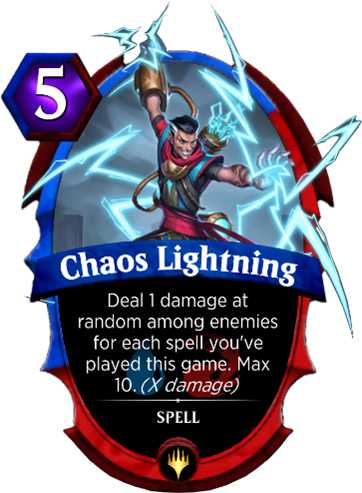
Spells mean something different in Spellslingers than they do in Magic. Here, spells are a discrete card type; in other words, in this game, because there is no “stack,” creatures are never “creature spells.” Artifacts are never “artifact spells.” Those cards go directly from being cards in your hand to being permanents on the battlefield.
Spells, instead, are one-shot cards you can cast on your turn for an immediate effect. This is also a good time to point out that in Spellslingers, the vast, vast majority of effects that alter a creature’s power and/or toughness do so permanently, for as long as the creature remains on the battlefield. This grants cards like Giant Growth — as well as Shock, Pyroclasm, and Infect — much more long-term impact than we’re used to.
This also means that, in real practice, Spells in this game are sort of a mix between sorceries and enchantments in Magic. Where some Spells are as straightforward as Divination (which has exactly the cost and effect you expect it to), others bestow lasting effects onto a creature, more like Auras — which is clearly intentional, given the borrowed flavor of cards like Oakenhide and Armadillo Cloak.
There are yet other spells that have effects that resemble global enchantments, like Fair Fight, which turns all creatures into 4/4s. However, this game so far seems to want to avoid static abilities, so Fair Fight only affects the creatures in play when it resolves.
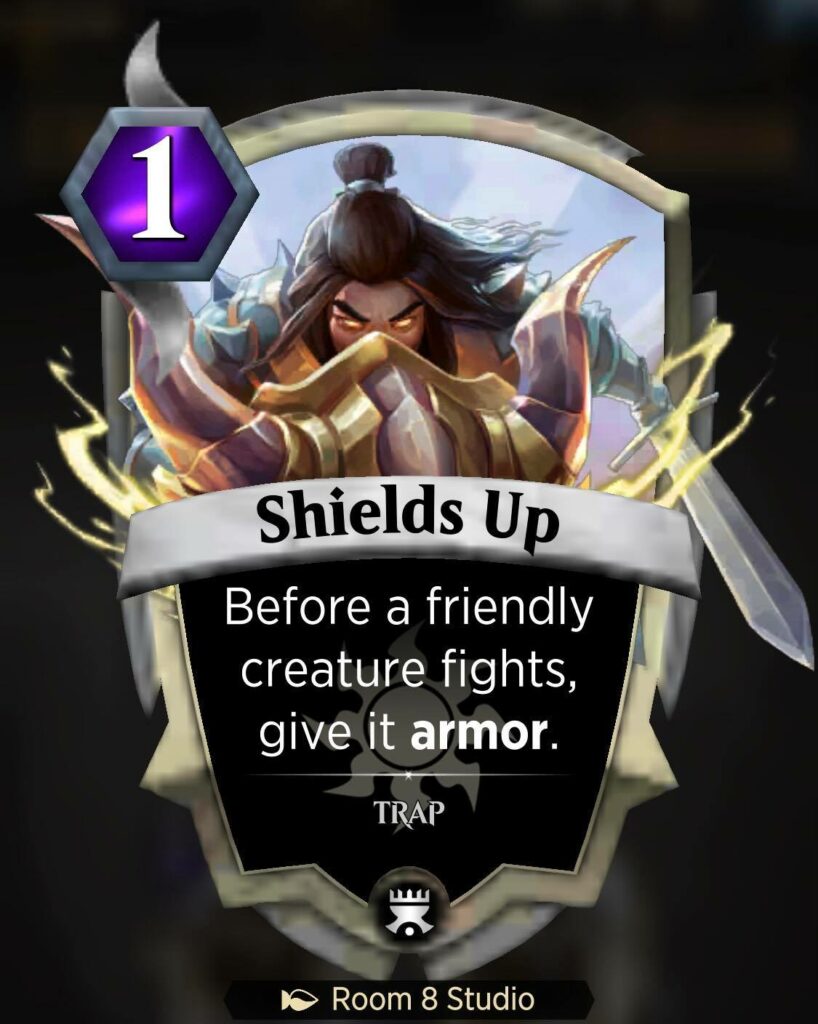
Traps are the “if-then” statements of Spellslingers. Despite borrowing their name from Yu-Gi-Oh!, they bring with them important nuance. They’re the closest thing this game has to instants, but they operate quite differently: you commit mana to them on your turn during one of your “main phases,” and they trigger when their conditions are met.
This makes for subtle, sometimes frustrating, gameplay. If you arm Shields Up, which says “Before a friendly creature you control fights, give it Armor,” it will trigger the first time any creature of yours fights any other creature. If you have a 4/4 and want to use this trap to have it kill an enemy 4/4 without dying, but your opponent uses their 2/2 to chump your 4/4, it feels bad (though it still prevented your 4/4 from becoming a 4/2).
A crucial thing to remember about Traps, and a massive distinction from Magic, is that Traps can trigger and resolve in the middle of another spell or ability resolving. I’ll talk about this more further down, under the subheading “Fight.”
When it comes to counterspell Traps, Spellslingers gives new meaning to “baiting out the counter.” If your opponent has Negate armed, you might play out your Millstone — forcing their Negate to trigger now, instead of on your game-winning removal spell.
Other traps, thankfully, are a little simpler. But there’s always some risk of an opponent anticipating what traps you’re running and looking for clever ways to play around them.
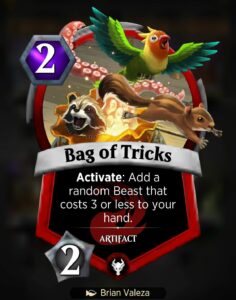
Artifacts in Spellslingers are a little weird and somewhat sidelined. Rather than true permanents that sit alongside creatures, here artifacts are off to the side in their own little space, up to a strict maximum of just two different artifacts at a time.
As there’s no tapping in this game, artifacts simply come with a preloaded number of “charges” or activations, which you can expend up to one of per turn, per artifact. When an artifact has zero charges, it disappears. (I think it goes to the graveyard, but I’m not 100% sure, as the game currently offers no way to view your graveyard.)
This means it’s often beneficial to sandbag the second copy of an artifact until the first one is used up. That creates a window where you can use the same artifact twice in a turn: the last charge of the first copy, and the first charge of the second copy. If you instead play the second copy while you already have one out, it will simply add its charges to the total of the original. (I have truly no clue if this puts a card in the graveyard. I don’t think it’s possible to tell without doing a convoluted test using Tarmogoyf. Big points to anyone who emails me below with the answer.)
(Update: Someone actually emailed us after doing a careful Tarmogoyf test! Adding more charges to an existing artifact does not put an artifact in your graveyard, but using up the last charge of an artifact does.)
Like with creatures, you can play a new artifact “on top” of an old one to replace it. As of the Helvault Unsealed expansion, this means artifacts with Finale will be exploitable just like creatures with Finale, as long as you have two artifacts on board.
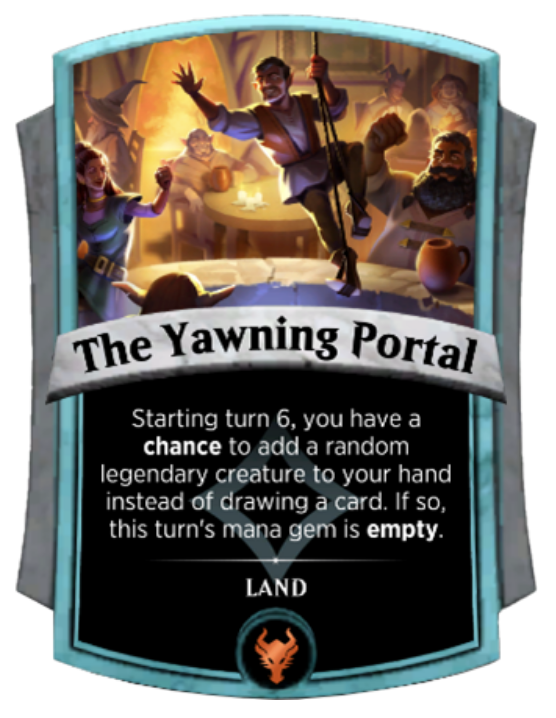
Lands comprise an interesting little nugget of game design here. Since Spellslingers wants to be a simple, sleek, and smooth experience, lands are kind of used as a way to approximate the flavor and feel of Magic in a game that is decidedly “not quite Magic.”
Every Spellslingers account has access to the five basic lands plus ten dual lands. All they say is “You get a mana gem every turn,” and you assign exactly one land to a deck as a constant effect. When you first start out, single-colored Slingers will only be able to use their associated basic, and two-colored Slingers will only be able to use their associated dual. A land is assigned to a deck, but it does not consume a slot in the 30-card deck construction requirement.
Where it gets interesting is with the utility lands available at Rare, Epic, and Mythic. Every color has one Rare and one Epic land, and each those essentially says, “Starting on turn X, you have a chance to get [some effect] instead of getting a mana gem.”
That’s right, you heard me: they replicated mana screw on purpose — to make it fun.
And…they succeeded?
I really enjoy these lands, as their effects — many of which offer “free” card advantage — are too tempting to ignore; yet they do lead to moments of tension where I’m going, “Please give me the mana! Please just give me the mana!”
Once you reach the relevant turn number, all of the Rare and Epic lands have a 30% chance of taking effect each turn, except for two: the top-tier Epic red land Molten Monastery gives you a 40% chance (!!!) of drawing an extra “temporary” card, similar to an “exile draw” in Magic; and the blue Epic, Tolarian Academy, starts you with one of the game’s very few static effects — a cost reduction of 1 to all your artifacts — with a 20% chance to increase that effect by 1 on later turns.
The two Mythic lands currently available are more unique. Both can be used in any deck of any color identity. Refreshment Stand gives each player a guaranteed, random multicolored card on their first turn; The Yawning Portal, the newest addition, has a chance to grant you a Legendary creature instead of a draw, while still giving you an empty mana gem rather than no new mana at all for the turn.
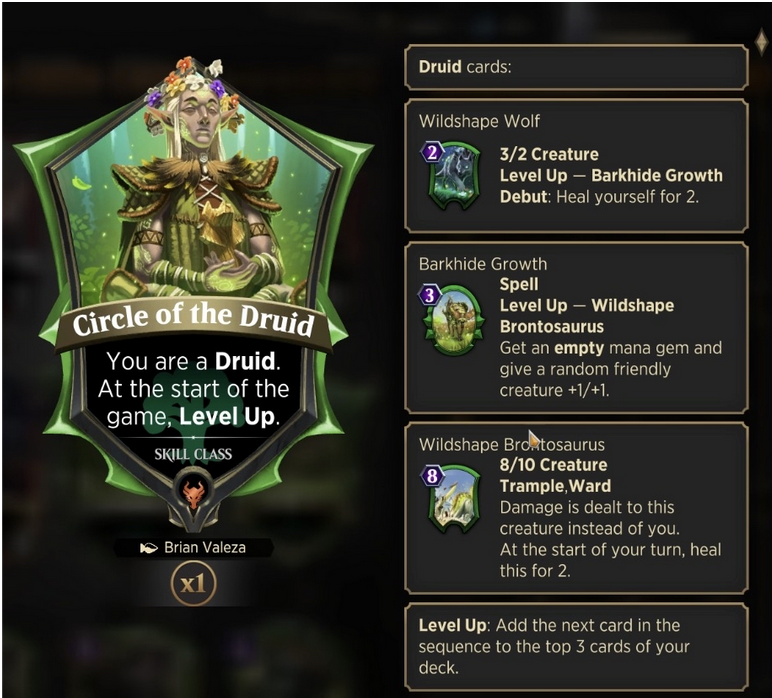
Skills are a brand new card type introduced in the D&D Icons mini-expansion, which is the first expansion since the game made the switch from beta to public release. The identity of Skills going forward is unclear at the present moment, as all five Skills released also have the (sub?)type “Class” with mechanics inspired by D&D classes.
Skills are somewhat similar to lands, in that you can only put one in your deck, and the Skill card itself is sort of separate from your main list (although a Skill, unlike a Land, does in fact take up a slot in your 30 cards). Everything else about the Skills released so far appears specific to the “Class” mechanic, so keep in mind that the remainder of this description may not apply to all future Skills.
When you have a Class in your deck at the start of the game, you “Level Up,” which means the first in a series of three cards is added to the top three cards of your deck (after your initial hand has been decided). When you successfully cast that card, you Level Up again, adding the next card in the series to your top three, and so on until you get to the third of these special cards. These final Class “ultimates” all give you a permanent effect similar to an Emblem in Magic, except for the green one, which is a huge self-healing dinosaur that takes damage instead of you.
Based on my experience, all of these Classes are making a significant impact in upper-league competitive play except for the red one. One of the interesting things about these Classes is the consistency they lend to your draws: all but red help you make sure you have creatures to play in the first three turns; and white, black, and to a lesser extent red ensure that you can find a three-mana removal spell in your first six draws.
Core Mechanics
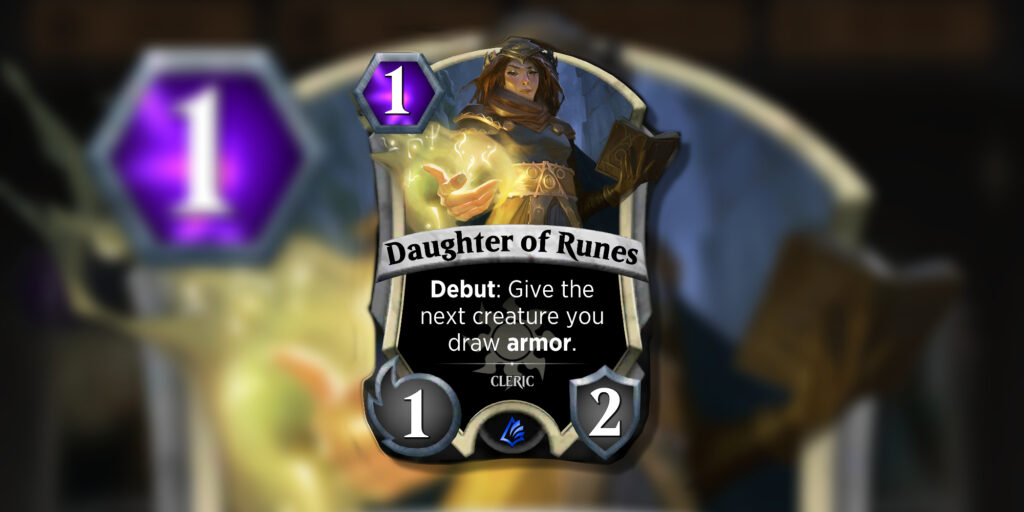
Debut is the Spellslingers take on “enters the battlefield” triggers. What the game doesn’t spell out well is that Debut effects only trigger when the creature enters the battlefield after being played from your hand.
This is important to remember. It means that Debuts won’t trigger in situations where you may expect them to: when a creature is reanimated; when created as a copy, like on Spawning Arowana or Blink Dog Pack; when created by some other triggered ability, like that of Mysterious Coccoon; or when created by a spell, like Unholy Recruitment.
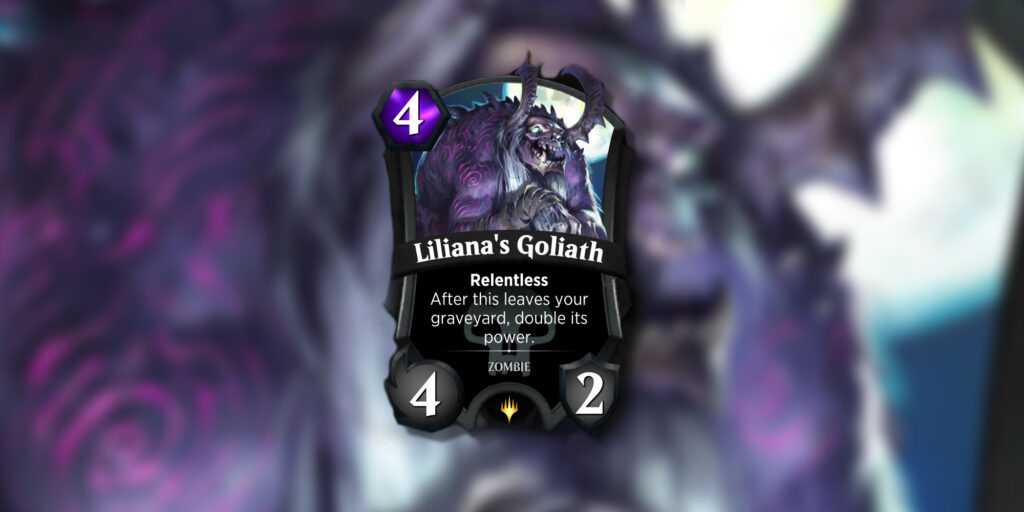
Finale is one of the more straightforward abilities. It’s essentially a “when this dies” trigger, and pretty much works the way you expect it to.
Relentless is a closely related ability. Translated to Magic templating, it means, “When this creature dies, return it to the battlefield. It loses Relentless and can’t block.” (That latter clause is why The Tarrasque has to say, “Always has Relentless.”)
Remember that when your board is full, you can play a new creature “on top” of an existing one to effectively sacrifice the replaced creature — and trigger its Finale ability. (Vraska exploits this well.) However, this doesn’t work with Relentless, since your board will remain full, leaving the Relentless creature no open slot to return to.
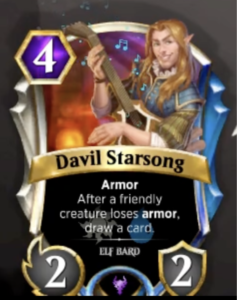
Armor is sort of like Magic‘s relatively new shield counters, though not as powerful. It prevents the first instance of damage a creature would receive, and then, just like Relentless above and several other keywords below, it goes away.
The thing to remember about Armor is that it only prevents damage. It will not prevent -X/-X effects (lethal or otherwise), and unlike MTG’s shield counters, it will not prevent “destroy” effects. It also doesn’t care whether the instance of damage would be lethal, which means that ping effects or low-damage spells like Shock can be used to clear Armor off of opposing creatures.
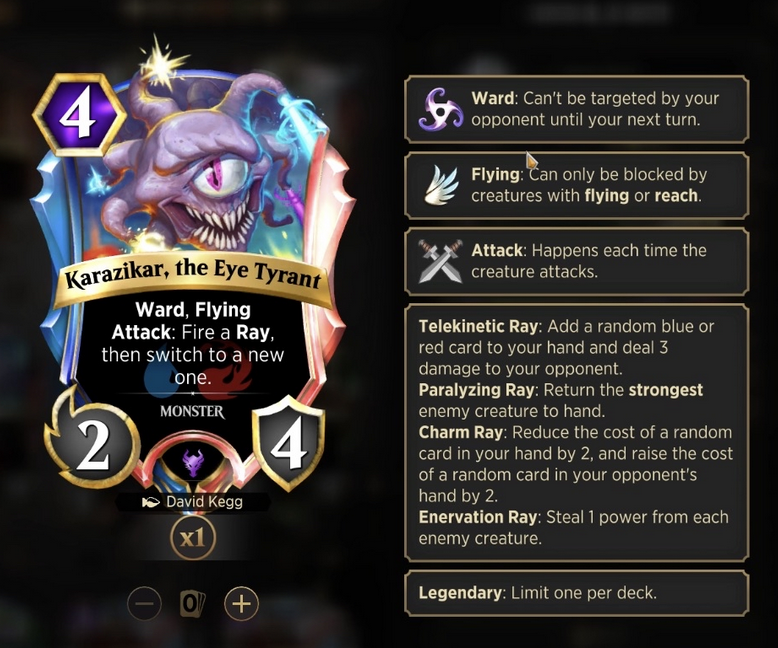
Ward is a deceptively powerful ability. The description is simple: “Can’t be targeted by your opponent until your next turn.” It’s closer to Magic‘s hexproof than it is to Magic‘s own ward, and it’s thankfully always temporary (so far).
It turns out that in a game with such a limited number of creatures and relatively aggressive mana:P/T ratios, keeping your creatures alive long enough to get in a clean swing (or two!) is surprisingly impactful. Cards like Karazikar above (who’s much cooler than his Magic iteration), Defend with Twinkle, and the Ward-granting engine Gladecover Warden were essential to the metagame dominance of pre-nerf Drizzt.

Note: This version of Fatal Infection is from the game’s beta period. It now costs 1.
Doom is another twist on “consumable abilities”: in this case, the ability consumes the creature. In terms of how the experience feels, most players would probably say that a doomed creature dies at the end of your opponent’s next turn.
In reality, however, the creature dies at the start of your next turn. This sounds minute, but it does have gameplay impacts, especially for Black-Green. If you’re Vraska, letting a creature die to doom — rather than, say, sacrificing it on your turn — means it will not get a doubled Finale trigger, because Vraska’s ability needs it to die during your turn. (Likewise, your Warlock Class ultimate’s “emblem” won’t trigger for 1 drain for the same reason.)
On the flipside, if you doom an enemy creature and your opponent lets doom run its course, the fact that the creature dies at the start of your next turn can be profitable for you — for example, if you windmill slam the BG staple Gluttonous Goo, which comes down as a 7/7 ward for 4 if a creature has died this turn.
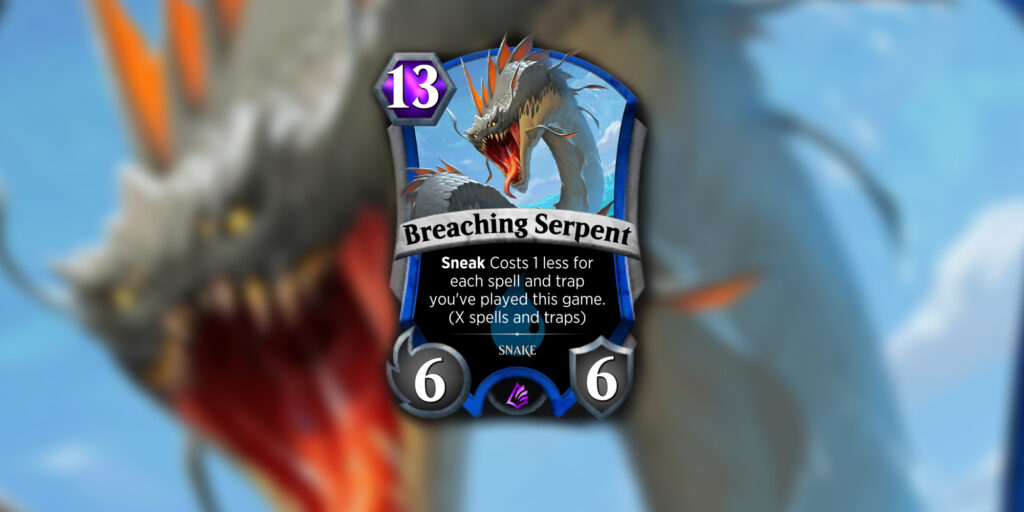
Sneak is another consumable keyword that makes a creature unblockable, then goes away once it’s been used to successfully deal combat damage to your opponent.
The subtlety and potency of Sneak is that it only goes away if something otherwise could have blocked it. So for example, if you give Sneak to a flying creature, it will still fly over grounded blockers without losing Sneak — and won’t “use up” its Sneak until you actually attack into a blocker with flying or reach. This is especially good with creatures that have triggered abilities upon hitting your opponent, like Counterfeiter, who can snatch you more than one card if your opponent doesn’t set up blocks early.
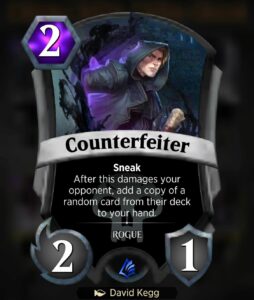
Before and After are essentially this game’s templating for the terms “When” or “Whenever” in Magic. They represent abilities that will trigger upon a certain event, and they specify whether they resolve…before or after that event. Most triggered abilites are templated either as a “before,” an “after,” or an “at” (as in “at end of turn”).
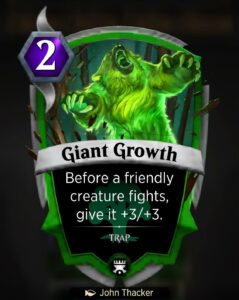
Fight in Spellslingers is synonymous with “creature combat.” As opposed to how it’s worded in Magic, “fighting” is not a distinct, separate mechanic from the way creatures deal damage to each other when blocking and being blocked. If anything, creature combat in Spellslingers is actually a subset of the broader mechanic called “fight.”
Things get a little complicated here.
Let’s zoom in for a moment on one of the best, most ubiquitous cards in Spellslingers so far: your old, humble friend, Giant Growth. As described above, this card grants a lasting +3/+3 for two mana, which is better than Oakenhide’s +2/+2 at the same cost — but it’s a Trap contingent on a fight happening, rather than an on-demand Spell.
To begin with, playing with and around Traps incentivizes varied lines of play. If you want Giant Growth to trigger on a specific creature of yours, you may choose to attack with only that creature. If you want to use it to take out a specific enemy creature, you might opt not to arm it until after your own combat step, carefully making sure that the first block you make on your opponent’s turn is the one where you want Giant Growth.
Or…you can arm the trap and then just force a fight to happen right away, with a card like the similarly ubiquitous Grudge Match. Grudge Match gives your creature +1/+1, then makes it fight a targeted enemy creature…but if you have Giant Growth or a similar trap armed, it will trigger and resolve in the middle of Grudge Match. Your creature will have gained a combined (permanent!) +4/+4 before the fight takes place.
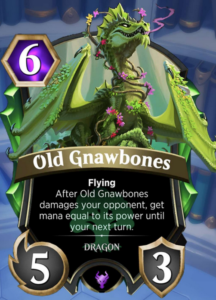
And that’s Part I!
This old gnawbones is tired, so I’ll leave it at that and see you all next installment — where we’ll dive into every single Spellslinger, all of their abilities and unique cards, and how to build effective decks around them. See you there!
SINISTRA BLACK (she/her) is a Los Angeles-based writer-director, Transgender Anarchist killjoy, and Bag of Tricks.
She publishes media essays and an email newsletter on her homepage, EASY ANSWERS. She can also be found on Twitter, Facebook, and other platforms, sharing humor, criticism, scorching takes, and Chaos Lightning.
She is available for hire or Spellslingers dates, but only if you foiled out your Yawning Portal.

